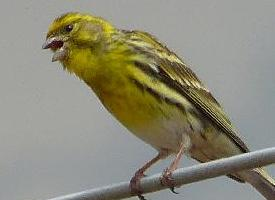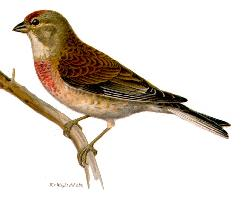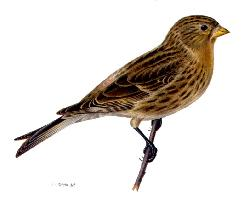
Description de l'animal
The Citril Finch (Carduelis citrinella) is a small, charming bird that belongs to the finch family, Fringillidae. This species is primarily found in the mountainous regions of southwestern and central Europe, with its range extending through parts of the Alps, the Pyrenees, and other localized mountain ranges. The Citril Finch is recognized for its adaptability to high-altitude environments, thriving in coniferous, mixed, and deciduous woodland habitats, as well as in alpine meadows up to the treeline.Characterized by its modest size, the Citril Finch measures about 11.5 to 12.5 centimeters in length and weighs approximately 12 to 15 grams. The bird exhibits a striking plumage that is a blend of muted and vibrant colors. Males are particularly notable during the breeding season, displaying a bright yellow breast and forehead that contrast beautifully against their greyish back and wings. The wings also feature two distinct white wing bars, which are visible in flight and while perched. Females and juveniles, on the other hand, are more subdued in coloration, with their plumage being a mix of grey and olive tones, allowing them to blend seamlessly into their natural surroundings.
The Citril Finch has a conical bill that is characteristic of finches, designed perfectly for cracking open seeds, which constitute the majority of its diet. During the breeding season, it may also feed on insects to provide additional protein for its young. This bird is a ground feeder, often seen foraging among the undergrowth and in open grassy areas for seeds from various alpine plants.
Breeding typically occurs from late spring to early summer. The Citril Finch is monogamous, with pairs forming strong bonds during the breeding season. Nests are meticulously constructed by the female, usually situated in the lower branches of a tree or bush, and are made from twigs, moss, and lined with finer materials such as feathers. The female lays between 3 to 5 eggs, which she incubates for about 13 to 14 days. Both parents are involved in feeding the altricial chicks, which fledge approximately 14 to 16 days after hatching.
The Citril Finch's song is a pleasant, trilling melody that is often heard during the breeding season as males sing to attract females and defend their territory. Their calls are a series of short, sweet notes that add to the auditory landscape of their mountainous homes.
Despite facing threats from habitat loss and fragmentation due to human activities, the Citril Finch is currently listed as Least Concern by the International Union for Conservation of Nature (IUCN), indicating that it is not presently at significant risk of extinction. However, conservation efforts remain important to ensure that this species, along with its habitat, is preserved for future generations to enjoy.
In summary, the Citril Finch is a small, yet vibrant bird whose life in the high-altitude regions of Europe showcases the remarkable adaptability and resilience of wildlife. Its striking appearance, melodious song, and fascinating behaviors make it a species of interest not only for ornithologists but also for nature enthusiasts and bird watchers alike.
Animaux similaires
Nouvelles photos d'animaux
Top 10 des animaux
- Dolphin gull (Leucophaeus scoresbii)
- Diana monkey (Cercopithecus diana)
- Moustached guenon (Cercopithecus cephus)
- Galápagos tortoise (Geochelone nigra complex)
- Japanese macaque (Macaca fuscata)
- Stone loach (Barbatula barbatula)
- Russian tortoise (Testudo horsfieldii)
- Greek tortoise (Testudo graeca)
- Common flying dragon (Draco volans)
- Vendace (Coregonus albula)


